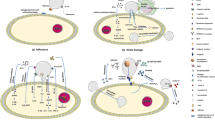Abstract
SPF white mice were inoculated intraperitoneally with 5 strains of saprophytic fungi of the mycelial genera Chrysosporium (C. keratinophilum, C. tropicutn) and Paecilomyces (P. lilacinus, P. marquandii, P. victoriae). The fungi caused granulomatous lesions in the peritoneal cavity and they were recultured (except P. lilacinus and P. marquandii) two months after inoculation. Spores, short hyphae and budding cells of all the fungi were observed in the granulomas stained by periodic-acid Schiff (PAS) and methenamine-silver nitrate (Grocott) techniques.
Similar content being viewed by others
References
Bader, G. & N.G. Bader. 1974. Morphologie der Gewebsformen von Erregern viszeraler Mykosen. 5. Mykosen 17: 265–285.
Baráthová, H., Z. Baráth & V. Betina. 1972. Dimorphism of Paecilomyces viridis controlled by antibiotics in vitro.I. Biológia (Bratislava) 27: 469–478.
Bilai, V.I. & I.A. Ellanskaya. 1972. Experimental morphogenesis of fungi. Mikol. Fitopatol. 6: 193–200.
Boisseau-Lebreuil, M.T. 1971. Identité des formes parasitaires de Emmonsia brasiliensis, E. ciferrina et de Chrysosporium pruinosum. C.R. Séanc. Soc. Biol. 165: 2419–2423.
Brandt, W.H. 1963. Dimorphism and interactions between the oak wilt fungus and associated fungi. Plant Dis. Rep. 47: 579–582.
Brown, A.H.S. & G. Smith. 1957. The genus Paecilomyces Bainier and its perfect stage Byssochlamys Westling. Trans. Br. mycol. Soc. 40: 17–89.
Carmichael, J.W. 1962. Chrysosporium and some other aleuriosporic Hyphomycetes. Can. J. Bot. 40: 1137–1173.
Cochrane, V.W. 1958. Physiology of Fungi. J. Wiley & Sons, New York.
Drouhet, E. 1972. Champignons opportunistes et mycoses iatrogènes. Bull. Inst. Pasteur 70: 391–464.
Dvořák, J. & Z. Hubálek. 1969. The growth of dermatophytes at 4°C and 37°C; the relation of this character to others. Mycopathol. 38: 305–312.
Egawa, H., M. Tsuda, A. Ueyama & T. Matuo. 1968. Formation of abnormal mycelium of Fusarium roseum Link on a modified Czapek-D amino acid medium. Experientia 24: 403–404.
Emmons, C.W. 1954. Isolation of Myxotrichum and Gymnoascus from the lungs of animals. Mycologia 46: 334–338.
Fenech, F.F. & C.P. Mallia. 1972. Pleural effusion caused by Penicillium lilacinum. Brit. J. Dis. Chest 66: 284–290.
Grocott, R.G. 1955. A stain for fungi in tissue sections and smears using Gomori's methenamine-silver nitrate technic. Am. J. clin. Path. 25: 975–979.
Henig, F.E., N. Lehrer, A. Gabbay & O. Kurz. 1973. Paecilomycosis of the lacrimal sac. Mykosen 16: 25–28.
Hubálek, Z. 1974. Fungi associated with free-living birds in Czechoslovakia and Yugoslavia. Acta Sci. nat. Brno 8, no.3: 1–62.
Hubálek, Z. 1977. Mouse inoculation with various saprophytic fungi. Mykosen 20: 229–234.
Hubálek, Z. & A. Balcaříková. 1969. Vorkommen von Aspergillen und Scopulariopsiden in den Hautläsionen der Haustiere. Mykosen 12: 611–619.
Jang, S.S., E.L. Biberstein, D.O. Slauson & P.F. Suter. 1971. Paecilomycosis in a dog. J. Am. Vet. Med. Ass. 159: 1775–1779.
Jičínská, E. 1974. Dimorphic and yeast-like mutants of the genus Cephalosporium Cda. Folia microbiol. 19: 1–4.
Kidd. G.H. & F.T. Wolf. 1973. Dimorphism in apathogenic Fusarium. Mycologia 65: 1371–1375.
Krempl-Lamprecht, L. 1965. Über das Vorkommen von Pilzen aus der Gattung Chrysosporium auf der Haut. ‘Krankheiten durch Schimmelpilze bei Mensch und Tier’ (ed. H. Grimmer & H. Rieth): 136–141. Springer Verlag, Berlin-Heidelberg-New York.
Maximova, R.A., A.B. Silyaev & N.P. Palmova. 1976. Development and differentiation of mycelium of Trichothecium roseum in submerged culture. Mikrobiologiya 45: 497–502.
Orr, G.F. 1970. Neogymnomyces, a new genus of the Gymnoascaceae. Can. J. Bot. 48: 1061–1066.
Otčenášek, M. & J. Dvořák, 1964. The isolation of Chrysosporium keratinophilum (Frey) Carmichael 1962 and similar fungi from Czechoslovakian soil. Mycopathol. 23: 121–124.
Pasteur, L. 1876. Études sur la bière. Gauthier Villars, Paris.
Patnaik, A.K., Liu, Si-Kwang, R.J. Wilkins, G.F. Johnson & P.E. Seitz. 1972. Paecilomycosis in a dog. J. Am. Vet. med. Ass. 161: 806–813.
Rippon, J.W. 1968. Monitored environment system to control cell growth, morphology, and metabolic rate in fungi by oxidation-reduction potential. Appl. Microbiol. 16: 114–121.
Rippon, J.W., T.P. Conway & A.L. Domes. 1965. Pathogenic potential of Aspergillus and Penicillium species. J. inf. Dis. 115: 27–32.
Rippon, J.W. & G.H. Scherr. 1959. Induced dimorphism in dermatophytes. Mycologia 51: 902–914.
Romano, A.H. 1966. Dimorphism. ‘The Fungi — An Advanced Treatise’ (ed. G.C. Ainsworth & A.S. Sussman), vol. 2: 181–209. Academic Press, New York.
Saëz, H. 1972–73. Terrain pulmonaire, survie ou parasitisme fongique: résultats de, l'examen de 134 primates. Vie Milieu 23: 335–356.
Saëz, H. & M.R. Battesti. 1976. Microsporum et microspories. II. Mykosen 19: 458–466.
Samšiňáková, A. 1964. Sporengewinnung von Beauveria bassiana (Bals.) Vuill. aus Submerskulturen. Naturwiss. 51: 121–122.
Schick, G. 1969. Dimorphismus bei Trichophyton mentagrophytes bei 25–37°C. Mykosen 12: 567–571.
Segretain, G., H. Fromentin, P. Destombes, E.R. Brygoo & A. Dodin. 1964. Paecilomyces viridis n. sp., champignon dimorphique, agent d'une mycose généralisée de Chameleo lateralis Gray. C.R. Acad. Sci D 259: 258–261.
Sternberg, T.H., J.E. Tarbet, V.D. Newcomer & L.H. Winer. 1952. Deep infection of mice with Trichophyton rubrum. J. invest. Derm. 19: 373–384.
Thirumalachar, M.J. 1972. Yeasts and yeast phases of fungi pathogenic to humans, animals and plants. Ind. Phytopath. 25: 183–187.
Uys, C.J., P.A. Schrire & C.N. Barnard. 1963. Endocarditis following cardiac surgery due to the fungus Paecilomyces. S. Afr. med. J. 37: 1276–1280.
Author information
Authors and Affiliations
Rights and permissions
About this article
Cite this article
Hubálek, Z., Hornich, M. Experimental infection of white mouse with chrysosporium and paecilomyces. Mycopathologia 62, 173–178 (1977). https://doi.org/10.1007/BF00444111
Issue Date:
DOI: https://doi.org/10.1007/BF00444111




